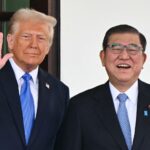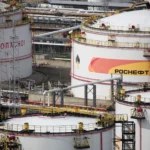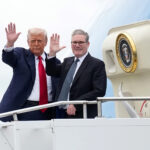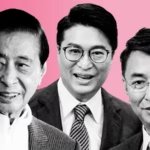How U.S. Sanctions Accidentally Helped Create China’s New $23 Billion AI Prodigy

In a twist no one in Washington intended, U.S. sanctions meant to cripple China’s access to advanced semiconductor and artificial intelligence capabilities have instead helped propel one of China’s youngest tech entrepreneurs into a $23 billion fortune—and turned him into a national symbol of resilience, innovation, and strategic adaptation.
The AI prodigy, once operating in the shadow of China’s tech titans, has now become the face of Beijing’s push for technological self-reliance. What began as an attempt by the United States to slow China’s AI rise has ironically hardened domestic ambition, redirected massive state and private investment into local companies, and accelerated the creation of an entirely new generation of Chinese AI giants.
The outcome is stark: in trying to weaken China’s AI ecosystem, U.S. sanctions helped create one of its most powerful players.
Sanctions as a Catalyst: How Pressure Turned into Opportunity
When Washington began imposing restrictions on Chinese access to cutting-edge chips and AI technology—particularly advanced Nvidia GPUs—analysts expected it to throttle China’s next wave of AI startups. Instead, the opposite happened.
The sanctions created:
- A vacuum in AI chip supply that domestic companies rushed to fill
- A surge in national investment toward homegrown AI companies
- Government-backed mega funding rounds for strategic startups
- Public enthusiasm for indigenous innovation
- A patriotic “buy local” tech movement across industries
And at the center of that momentum was the young founder who now stands as China’s newest AI billionaire.
Because foreign competitors were banned or restricted, his company suddenly became the only viable supplier in several key AI hardware and software categories. Demand exploded overnight.
Within 18 months, his company went from a promising startup to a core pillar of China’s AI ecosystem, raising billions in state-aligned capital and landing partnerships with national champions in telecoms, cloud computing, manufacturing, defense, and smart-city infrastructure.
China’s AI Prodigy: From Researcher to National Tech Icon
Though still in his 30s, the entrepreneur had already built a reputation as an engineering prodigy:
- A background in deep learning research
- Stints at leading international labs before returning to China
- Early recognition for breakthroughs in algorithm optimization
- A sharp ability to scale from research to product commercialization
- A loyal team of top engineers trained in AI design and architecture
But it was the sanctions that truly launched him into the spotlight—forcing major Chinese corporations and government institutions to adopt homegrown AI infrastructure.
Within a year:
- His company’s valuation soared into the tens of billions
- He became one of the youngest mega-billionaires in China
- State media began portraying him as a “symbol of China’s technological awakening”
- Domestic competitors and global investors took notice
- Local governments competed to build industrial parks centered around his hardware and software ecosystem
For a country seeking its own Silicon Valley heroes, he became a phenomenon overnight.
U.S. Sanctions Reshaped China’s AI Industry—Just Not as Intended
Washington’s goal was clear: prevent China from accessing the world’s most advanced AI chips and slow its rise in military and commercial artificial intelligence.
But the effects have been mixed.
Sanctions created three major unintended outcomes:
1. Domestic Substitution at Hyper Speed
Chinese firms—backed by central and provincial governments—moved aggressively to replace foreign suppliers across the entire AI stack.
2. A Surge in Local Capital
China’s largest investment institutions shifted billions into AI chipmakers, model developers, and AI infrastructure providers.
3. National Unity Around Tech Self-Sufficiency
Beijing used U.S. sanctions to rally public support behind domestic tech companies, turning the sanctions into a patriotic economic challenge.
The result:
An accelerated domestic AI ecosystem built around local champions.
How a $23 Billion Fortune Was Made: The Business Behind the Boom
The AI prodigy’s wealth surge stems from several explosive growth areas:
1. AI Chips Designed for “Sanction-Resistant” Deployment
His company builds processors optimized for AI inference and training, using architecture tailored to bypass export controls.
2. Domestic Cloud Partnerships
Major Chinese cloud providers—locked out of top-tier foreign chips—adopted his company’s solutions to maintain competitiveness.
3. Smart-City and Industrial AI Integration
Local governments deployed his systems for surveillance, public administration, traffic control, energy optimization, and logistics.
4. Military-Adjacent Applications
Though not publicly disclosed, analysts believe his technology supports defense-related AI infrastructure.
5. A Growing Global Market Among Sanctioned States
Countries facing Western export restrictions—across Asia, the Middle East, and parts of Africa—have become unexpected buyers.
This combination of national demand, geopolitical necessity, and global supply gaps turned his startup into an empire.
China’s New AI Landscape: Homegrown and Hardening
With foreign technology restricted, China’s AI industry has reorganized around domestic pillars:
- AI chips (NPU/GPU alternatives)
- Large language models
- Robotics and automation
- Edge computing
- Autonomous vehicles
- National cloud ecosystems
The prodigy’s company sits at the intersection of all these sectors.
His success is part of a broader trend: China is building its own AI world, independent from U.S. technology, supply chains, and platforms.
What This Means for U.S.–China Tech Competition
The rise of China’s new $23 billion AI billionaire is a warning sign for Washington: sanctions may slow China temporarily, but they also accelerate Beijing’s long-term strategy of building fully sovereign technological capacity.
Three strategic implications stand out:
1. China Is Becoming More Self-Sufficient
The country is more determined than ever to stop relying on U.S. hardware.
2. The Global AI Ecosystem Is Splitting
A dual AI world is emerging:
- A U.S.-centric model
- A China-centric, sanctions-resistant alternative
3. Sanctions Are Creating New Megafirms in China
Rather than weakening China’s tech industry, restrictions are reshaping it—creating new champions built for geopolitical confrontation.
Conclusion: Sanctions Sparked a New Chinese AI Titan
In attempting to contain China’s AI ambitions, U.S. sanctions have unintentionally created one of the most powerful entrepreneurs in China’s technological rise. The new $23 billion AI prodigy embodies the paradox of modern geopolitics:
Pressure meant to suppress innovation instead ignited it.
His success signals a turning point—not only for China’s AI development, but for the global technology race. What began as a wartime-style economic restriction has become the catalyst for a peace-time technological revolution within China.
The age of Chinese homegrown AI is accelerating faster than anyone expected—and its new champions are just getting started.



















